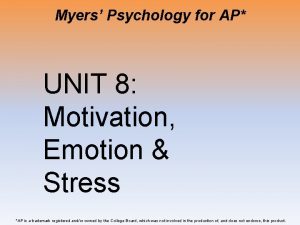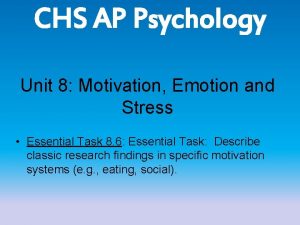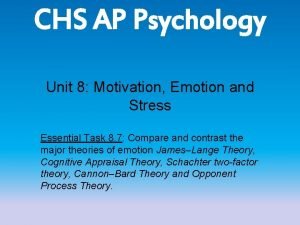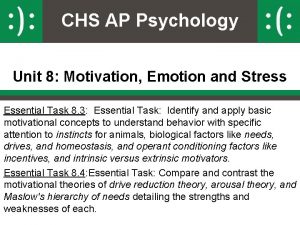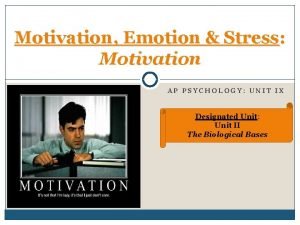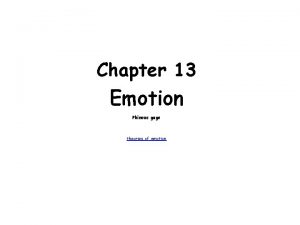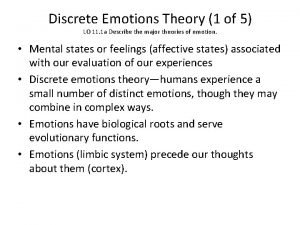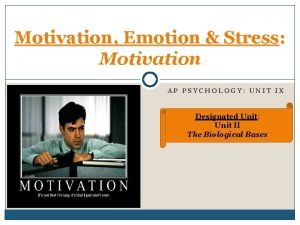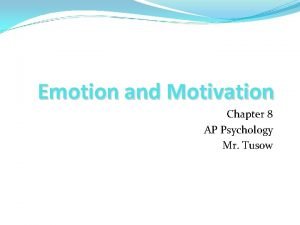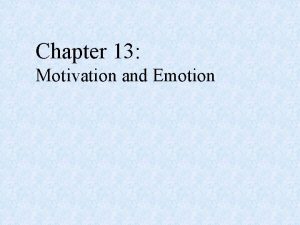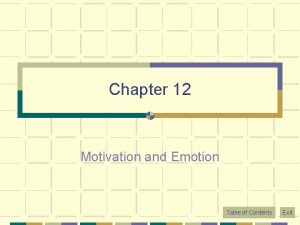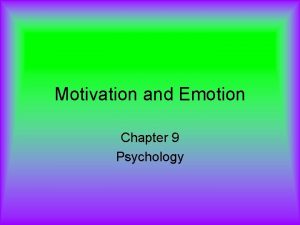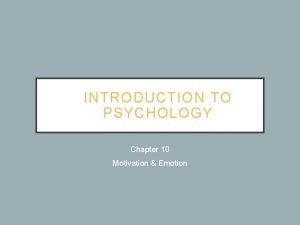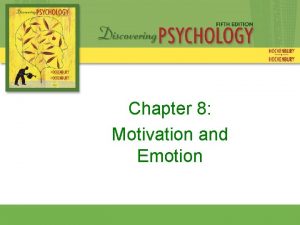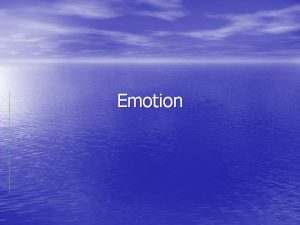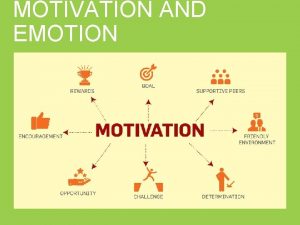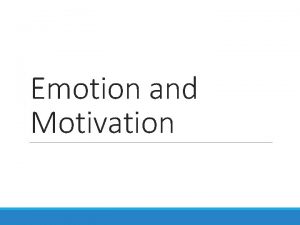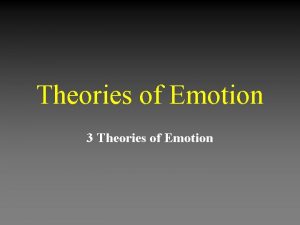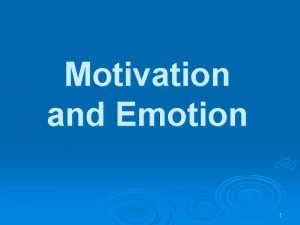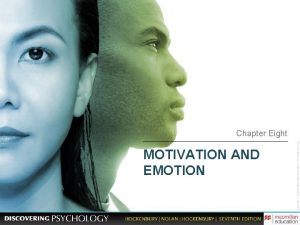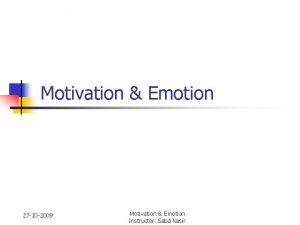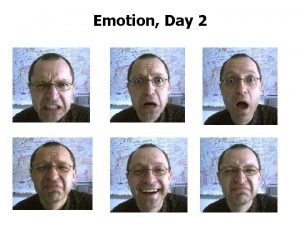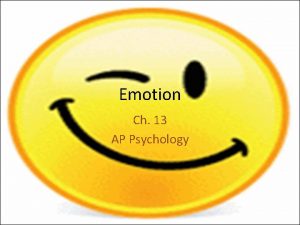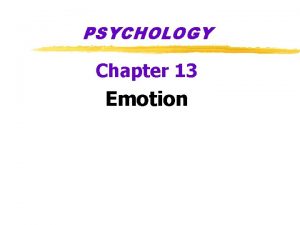THEORIES OF MOTIVATION UNIT VIII MOTIVATION AND EMOTION














- Slides: 14

THEORIES OF MOTIVATION UNIT VIII MOTIVATION AND EMOTION

Drive Reduction Theory Arousal Theory Human Drives Intrinsic/ Extrinsic Motivation We are here Maslow’s Hierarchy of Needs Motivation Motivatio n& Emotion Stress Effects Theories of Emotion James-Lange Cannon. Bard Measure s Sources Explain complex motives (eating, aggression, achievement and sex) Theories Opponent Process Cognitive Appraisal Schachter two-factor Coping

WHAT IS MOTIVATION? • ____- is a need or want that causes us to act. • ____- directs and maintains goal-directed behavior. • _______- explain the relationship between physiological changes and emotional experiences.

THEORIES OF MOTIVATION 1. Instinct Theory 2. Drive- Reduction Theory 3. Incentive Theory 4. Arousal Theory 5. Hierarchy of Motives

INSTINCT THEORY • ______- physical and ____ instincts such as curiosity and fearlessness cause us to act. • _____- are inherited automatic species-specific behaviors. • Ex: Birds and butterflies flying South for the winter; salmon swimming upstream to mate • ______ with theory: • Are there any human behaviors that can be considered true instincts? • How much of human behavior is instinctive?

DRIVE-REDUCTION THEORY • When the ______ of motivation failed it was replaced by the drive-reduction theory. • ________- a physical need creates an aroused _____ state (a drive) that motivates an organism to _____ the need (Hull, 1951)

DRIVE REDUCTION The ______ aim of drive reduction is ________. Homeostasis- the maintenance of a steady internal state-_____. The regulation of any aspect of ________ around a particular level. Drive Reduction Food Empty Stomach Full (Food Deprived) Organism 7

DRIVE-REDUCTION THEORY • Strengths • Does a nice job explaining most _____ drives • Falls apart with more complex behaviors/_____ drives • ____ and Secondary Drives

INCENTIVE THEORY • ______- beyond the ____ motives of food, drink, and sex that push us toward a goal, ____ motives or external stimuli such as _______, approval, and grades regulate and pull us towards a ____. • _____- a positive or negative environmental stimulus that motivates behavior.

OPTIMUM AROUSAL • Humans seek _____ levels of arousal. • Sometimes we want _______ of arousal • Sometimes we want very ______ arousal • Some of us tend to want _______ and some of us tend to want ____.

AROUSAL THEORY • People do things in order to seek out an ____ level of arousal for a given moment, • I want a _______ level of arousal- let’s do something epic tonight. • I want a ______ level of arousal- let’s stay in tonight. • I am _______ with my life, I need a new job. • I am stressed at work, let’s take a ____.

YERKES-DODSON LAW • States that there is an _______ level of arousal for best performance on any task. • The more ______ the task, the ____ the level of arousal that can be tolerated without interfering with performance.

HIERARCHY OF NEEDS • Abraham ______ (1970) suggested that certain needs have priority over others. • ______ needs like breathing, thirst, and hunger come before ______ needs such as achievement, self-esteem, and the need for recognition. (1908 -1970)

HIERARCHY OF NEEDS
 Bulimia nervosa definition ap psychology
Bulimia nervosa definition ap psychology Unit 8 motivation emotion and stress
Unit 8 motivation emotion and stress Ap psychology unit 8 motivation and emotion test
Ap psychology unit 8 motivation and emotion test Ap psychology unit 8
Ap psychology unit 8 What motivates you
What motivates you Ap psychology motivation and emotion activities
Ap psychology motivation and emotion activities Two factor theory of emotion example
Two factor theory of emotion example What is discrete emotions theory
What is discrete emotions theory Incentive theory ap psychology
Incentive theory ap psychology 2 factor theory of emotion
2 factor theory of emotion Chapter 13 motivation and emotion
Chapter 13 motivation and emotion Chapter 12 motivation and emotion
Chapter 12 motivation and emotion Example of motivation
Example of motivation Chapter 10 motivation and emotion
Chapter 10 motivation and emotion Chapter 8 motivation and emotion
Chapter 8 motivation and emotion
